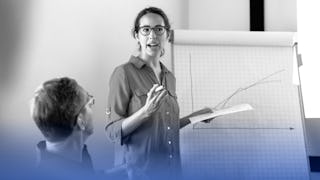The hope good presenters project when pitching their ideas is not naïve hope. They’re not Pollyanna at the podium. Instead, the solutions they offer are supported by research, data, and expertise. This course will teach you how to merge hard facts with an imaginative vision in a way that at once resonates with and inspires your audience.



Speaking and Presenting: Pitches and Persuasion
This course is part of Good with Words: Speaking and Presenting Specialization

Instructor: Patrick Barry
10,661 already enrolled
Included with
(92 reviews)
Recommended experience
What you'll learn
How to inspire people with a sense of "informed hope"
How to treat storytelling as an "entrepreneurial superpower"
How to expand your range of dynamic gestures and facial expressions
How to increase the creativity you bring to your next negotiation
Skills you'll gain
Details to know

Add to your LinkedIn profile
8 assignments
See how employees at top companies are mastering in-demand skills

Build your subject-matter expertise
- Learn new concepts from industry experts
- Gain a foundational understanding of a subject or tool
- Develop job-relevant skills with hands-on projects
- Earn a shareable career certificate

There are 4 modules in this course
What do the British writer George Orwell and the American designer Charles Eames have in common? We’ll find out in this first week of “Pitches and Persuasion,” the second course in the four-part series “Good with Words: Speaking and Presenting.”
What's included
6 videos10 readings2 assignments3 discussion prompts
We’ll take a deeper look at the quality of optimism this week, with a little help from a 19th-century neurologist, a 20th century graduate of Harvard Law School, and a set of 21st-century experiments. It’s going to be a fun week.
What's included
3 videos4 readings2 assignments1 app item1 discussion prompt
We’ll start by taking a new look at Martin Luther King Jr.’s famous “I Have a Dream Speech” at the March on Washington in 1963. But we won’t be focusing on his rhythmic cadence or strategic uses of pauses. Instead, we’ll turn our attention to the persuasive power he generates with his head, his arms, and even his heels. Body language, we’ll see, can be some of the most effective languages around.
What's included
6 videos3 readings2 assignments3 discussion prompts
The first American woman to become a Supreme Court justice. The first German Chancellor to commemorate the Warsaw Ghetto Uprising. And a brave political activist who decided the best way to make a statement would be to climb up a flagpole. We learned about each of those figures last week and are now ready to take a look at some helpful research about the quality each of them shared: they communicated with more than just their mouths.
What's included
3 videos4 readings2 assignments4 discussion prompts
Earn a career certificate
Add this credential to your LinkedIn profile, resume, or CV. Share it on social media and in your performance review.
Instructor

Offered by
Explore more from Personal Development
 Status: Free Trial
Status: Free Trial Status: Free Trial
Status: Free TrialUniversity of Michigan
 Status: Free Trial
Status: Free TrialJohns Hopkins University
Why people choose Coursera for their career




Learner reviews
92 reviews
- 5 stars
82.79%
- 4 stars
9.67%
- 3 stars
2.15%
- 2 stars
1.07%
- 1 star
4.30%
Showing 3 of 92
Reviewed on Nov 21, 2021
A very good course, taught by an exceptional instructor. It has helped me a lot in both my personal and professional life.
Reviewed on Jun 1, 2023
Great practical course for those who speak in public, including lawyers and teachers.

Open new doors with Coursera Plus
Unlimited access to 10,000+ world-class courses, hands-on projects, and job-ready certificate programs - all included in your subscription
Advance your career with an online degree
Earn a degree from world-class universities - 100% online
Join over 3,400 global companies that choose Coursera for Business
Upskill your employees to excel in the digital economy
Frequently asked questions
To access the course materials, assignments and to earn a Certificate, you will need to purchase the Certificate experience when you enroll in a course. You can try a Free Trial instead, or apply for Financial Aid. The course may offer 'Full Course, No Certificate' instead. This option lets you see all course materials, submit required assessments, and get a final grade. This also means that you will not be able to purchase a Certificate experience.
When you enroll in the course, you get access to all of the courses in the Specialization, and you earn a certificate when you complete the work. Your electronic Certificate will be added to your Accomplishments page - from there, you can print your Certificate or add it to your LinkedIn profile.
Yes. In select learning programs, you can apply for financial aid or a scholarship if you can’t afford the enrollment fee. If fin aid or scholarship is available for your learning program selection, you’ll find a link to apply on the description page.
More questions
Financial aid available,


